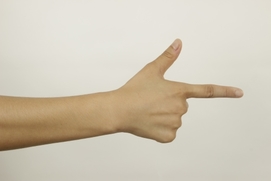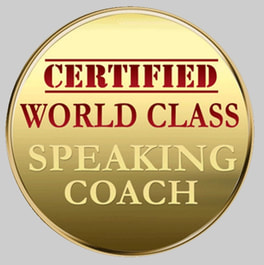
When I’m lost during a road trip, which happens more often than I’d like to admit, I’m not very good at stopping the car and asking for directions. Then again I am a man. My fiancée Iryna (also my business partner and coach in Speechcamp) has no problem asking and receiving. She’s the perfect co-pilot and navigator.
Recently, we travelled to Iryna’s home country of Belarus, where the spoken language is mostly Russian. We were looking for the correct route to an auto-repair garage (don’t ask, that’s another story), and so at Iryna’s request I pulled over so she could ask someone for help. An old man limped over to her window. As I waited for the inevitable onslaught of Russian I thought to myself, “I’m not going to understand any of this.” I was, of course, happily resigned to let Iryna assimilate the info.
Something unexpected happened, however. By the end of the old man’s monologue I had a good sense of where we needed to go. He spoke Russian for sure, and my Russian is not that good… yet. But somehow I just knew we had to take a right at the second traffic lights, then the next left, and the garage would be on the left hand side somewhere. Was I right? Drumroll…
Well, not exactly, but I was close. It was the third traffic lights, but everything else was spot on. Why? It instantly struck me how he managed to communicate to me. It was through his body language… specifically his hand gestures.
“Bloody hell”, I said, in perfect English.
I’d been immersed in the world of public speaking for nine years and it was only in that moment I understood the relative power of hand gesturing.
It’s time to face the elephant in the room – hand gesturing is a seriously under-appreciated sub-skill tucked within the frequently hyped arena of body language. We’re often telling our clients to stand up straight, dress well, smile, move with purpose… yes, those are great tips by the way… But what of these two hands, eh? They are so damn powerful.
Think about it… if someone gives you directions to somewhere you need to go, and they use their hands to reach, point and make turning signals, it’s a hell of a lot more helpful and engaging than someone who holds their hands by their sides while they explain the directions using only words. If it works for the old man from Belarus, why wouldn’t you use hand gestures during your speeches to help your audience understand where you are taking them?
Let’s face it, much of the time when we speak we are afraid of what to do with our hands.
“What the hell do I do with these things”, I’ve heard more than one client ask me, as they lay out their palms before me, as if waiting for me to smack each one with a stick. It’s time to end the madness...
Let me offer you some powerful tips that will help you to get those hands moving with poise, purpose and most importantly… passion.
Hand gestures can generally be bunched into five categories…
1) Measurement
2) Emotional
3) Propping
4) Pointing
5) Painting
Measurements are easy. Everyone can do them. Frequently in my courses I ask my students to stand up, and with their hands convey the following (try them now):
1) The number four
2) Something massive
3) Something small in length
4) Something tiny
5) Something heavy
That was easy, right? Just be careful in how you convey the number two.
You can also count out lists using your hands to mark each item. You have up to ten digits to work with, so that’s more than enough. Note that sizes can be relative to the concepts you are showing the measurement of. For example, I could convey a large fish by holding my hands vertically two feet apart, palms facing each other. However I could also use exactly the same gesture to convey a narrow road. It’s all relative so trust your instincts and have fun.
Emotional gestures convey energy, passion and enthusiasm. They are a great way to channel nervous energy, as long as you don’t overdo it. Watch your average Italian or Spaniard when they speak. It’s not for everyone, sure, but I’m willing to bet a million euro when you are in the pub arguing with your friends about who won the X-Factor final the night before, your hands are expressing something. And I bet you're not self-conscious about them.
You can also convey more specific emotions with your hands. If I ask my students to show me anger, they clench their fists. If I ask them to show joy or happiness, or to convey friendliness or openness, I might get the outstretched palms-out Jesus-style gesture. You can also convey passionate emphasis, for example thumping a fist on a palm to hammer home a point.
Propping is where you convey imaginary objects (props, in effect) with your hands. If I ask you to show the universal symbol for being on the phone… well, you know the one – thumb and little pinky out-stretched, the middle fingers curled up, and hold vertically to the ear. You can paint a lot of props with your hands. Try the following:
1) Open a can of beer (or soda, if you don’t drink alcohol (or soft drink if you don’t like American terms))
2) Open a can of worms (and empty it on the floor)
3) Open an umbrella and put it over your head
Fun, isn’t it?
Pointing is what Mr. Belarus did. You basically convey directions. Try showing me:
1) The sky
2) Underneath the ground
3) Around a corner (to the right)
Top tip: Never point directly at your audience, or wag your finger at them. It makes them feel like they are back in school. Instead, point using your whole hand (with palm up and out).
Painting is the most powerful of all. This is where you can use your hands to portray entire locations and/or scenes. They are fantastic for enriching the audience’s imagination, especially during storytelling.
Two months ago I asked a corporate client to tell me a story about his favourite holiday destination. He wasn’t very expressive with his hands, so he proceeded to talk of “tall mountains”, “sandy beaches”, “tall buildings”, and so on. Then I asked him to re-tell the story but this time use his hands to paint the mountains (zig-zagging his hand across the stage in front of him), give us a sense of the beach (sweeping off to the left of the stage), tall buildings (reaching up high)… and many more. The second rendition of his story was a much more immersive and engaging experience. The penny dropped for him and our audience of students. Painting with your hands works wonders.
I recall another client who was developing a technical speech about production levels in a factory. To enhance the experience for his audience, I coached him to portray production rooms as locations on the stage (a few sweeping hand gestures worked nicely). He also portrayed conveyor belts and the outlines of machines. It gave the audience a sense of real places with real objects.
Hand gestures can make all the difference between average or potentially boring… and immersive and engaging. Next time you feel fear at the thought of using your hands, tell that fear to talk to the hand.
Author: Eddie O'Hanlon
Recently, we travelled to Iryna’s home country of Belarus, where the spoken language is mostly Russian. We were looking for the correct route to an auto-repair garage (don’t ask, that’s another story), and so at Iryna’s request I pulled over so she could ask someone for help. An old man limped over to her window. As I waited for the inevitable onslaught of Russian I thought to myself, “I’m not going to understand any of this.” I was, of course, happily resigned to let Iryna assimilate the info.
Something unexpected happened, however. By the end of the old man’s monologue I had a good sense of where we needed to go. He spoke Russian for sure, and my Russian is not that good… yet. But somehow I just knew we had to take a right at the second traffic lights, then the next left, and the garage would be on the left hand side somewhere. Was I right? Drumroll…
Well, not exactly, but I was close. It was the third traffic lights, but everything else was spot on. Why? It instantly struck me how he managed to communicate to me. It was through his body language… specifically his hand gestures.
“Bloody hell”, I said, in perfect English.
I’d been immersed in the world of public speaking for nine years and it was only in that moment I understood the relative power of hand gesturing.
It’s time to face the elephant in the room – hand gesturing is a seriously under-appreciated sub-skill tucked within the frequently hyped arena of body language. We’re often telling our clients to stand up straight, dress well, smile, move with purpose… yes, those are great tips by the way… But what of these two hands, eh? They are so damn powerful.
Think about it… if someone gives you directions to somewhere you need to go, and they use their hands to reach, point and make turning signals, it’s a hell of a lot more helpful and engaging than someone who holds their hands by their sides while they explain the directions using only words. If it works for the old man from Belarus, why wouldn’t you use hand gestures during your speeches to help your audience understand where you are taking them?
Let’s face it, much of the time when we speak we are afraid of what to do with our hands.
“What the hell do I do with these things”, I’ve heard more than one client ask me, as they lay out their palms before me, as if waiting for me to smack each one with a stick. It’s time to end the madness...
Let me offer you some powerful tips that will help you to get those hands moving with poise, purpose and most importantly… passion.
Hand gestures can generally be bunched into five categories…
1) Measurement
2) Emotional
3) Propping
4) Pointing
5) Painting
Measurements are easy. Everyone can do them. Frequently in my courses I ask my students to stand up, and with their hands convey the following (try them now):
1) The number four
2) Something massive
3) Something small in length
4) Something tiny
5) Something heavy
That was easy, right? Just be careful in how you convey the number two.
You can also count out lists using your hands to mark each item. You have up to ten digits to work with, so that’s more than enough. Note that sizes can be relative to the concepts you are showing the measurement of. For example, I could convey a large fish by holding my hands vertically two feet apart, palms facing each other. However I could also use exactly the same gesture to convey a narrow road. It’s all relative so trust your instincts and have fun.
Emotional gestures convey energy, passion and enthusiasm. They are a great way to channel nervous energy, as long as you don’t overdo it. Watch your average Italian or Spaniard when they speak. It’s not for everyone, sure, but I’m willing to bet a million euro when you are in the pub arguing with your friends about who won the X-Factor final the night before, your hands are expressing something. And I bet you're not self-conscious about them.
You can also convey more specific emotions with your hands. If I ask my students to show me anger, they clench their fists. If I ask them to show joy or happiness, or to convey friendliness or openness, I might get the outstretched palms-out Jesus-style gesture. You can also convey passionate emphasis, for example thumping a fist on a palm to hammer home a point.
Propping is where you convey imaginary objects (props, in effect) with your hands. If I ask you to show the universal symbol for being on the phone… well, you know the one – thumb and little pinky out-stretched, the middle fingers curled up, and hold vertically to the ear. You can paint a lot of props with your hands. Try the following:
1) Open a can of beer (or soda, if you don’t drink alcohol (or soft drink if you don’t like American terms))
2) Open a can of worms (and empty it on the floor)
3) Open an umbrella and put it over your head
Fun, isn’t it?
Pointing is what Mr. Belarus did. You basically convey directions. Try showing me:
1) The sky
2) Underneath the ground
3) Around a corner (to the right)
Top tip: Never point directly at your audience, or wag your finger at them. It makes them feel like they are back in school. Instead, point using your whole hand (with palm up and out).
Painting is the most powerful of all. This is where you can use your hands to portray entire locations and/or scenes. They are fantastic for enriching the audience’s imagination, especially during storytelling.
Two months ago I asked a corporate client to tell me a story about his favourite holiday destination. He wasn’t very expressive with his hands, so he proceeded to talk of “tall mountains”, “sandy beaches”, “tall buildings”, and so on. Then I asked him to re-tell the story but this time use his hands to paint the mountains (zig-zagging his hand across the stage in front of him), give us a sense of the beach (sweeping off to the left of the stage), tall buildings (reaching up high)… and many more. The second rendition of his story was a much more immersive and engaging experience. The penny dropped for him and our audience of students. Painting with your hands works wonders.
I recall another client who was developing a technical speech about production levels in a factory. To enhance the experience for his audience, I coached him to portray production rooms as locations on the stage (a few sweeping hand gestures worked nicely). He also portrayed conveyor belts and the outlines of machines. It gave the audience a sense of real places with real objects.
Hand gestures can make all the difference between average or potentially boring… and immersive and engaging. Next time you feel fear at the thought of using your hands, tell that fear to talk to the hand.
Author: Eddie O'Hanlon





 RSS Feed
RSS Feed
